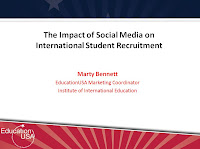Any commitment in life should be taken seriously, and, to be done well, should involve a willingness to invest in that relationship, project, or strategy over a period of time. More importantly, to succeed you need to be relevant and appealing whether that be to a significant other, business partner, or institution.
The greatest professional frustration I hear from colleagues in international student enrollment management circles comes when a college/university administration pays only lip service to how much value they place on international students and/or refuses to commit over a period of time to allow a particular change in strategy or the opening of new markets to have a chance of success. Too often administrations that don't understand international markets well (or know the implications of expanded international enrollments on campus life) see full fee-paying students from overseas as quick fixes for enrollment and/or budgetary shortfalls. That's a topic for another day, but the same commitment to these kinds of strategies as a institution should also apply to outreach conducted through social media.
Get Connected
As I outlined in my previous post, step one is identifying where key student audiences are in target countries/regions, next is establishing a presence on those platforms. Who does that at each institution will vary dramatically depending on the size of the college as well as the marketing and communication/IT office's role on campus. Let's say for argument's sake we say that the admissions or international office that is responsible for recruitment abroad takes on this role. Speaking with one voice is key in this process, which can involve multiple individuals contributing, but certainly makes training an absolute must. One blogger that speaks to the importance of character & commitment in social media is Tony Teegarden. If you are becoming more immersed in this world, give Tony a quick follow.
In social media world, however, it is essential that going in, everyone understands, institutions no longer control the message. If there are any doubters out there, please have them watch Social Media Revolution 2 (refresh) put out by Socialnomics last year. It really explains the fundamental shift from traditional marketing approaches to a listen first, sell second attitude.
Stay Involved
If there ever was an antithesis formula for success to the Field of Dreams approach, social media is it. Throwing up a page or group on Facebook, simply having a Twitter feed or YouTube channel simply is not good enough. Messaging on a regular basis, responding to comments (especially negative ones), re-tweeting, sharing, and managing what kind of content gets posted are bedrock essentials that will require continual care to see growth and eventually to bear fruit. Think about a school like MIT, where the admissions office's homepage for at least the last two years, has been driven, content-wise, by student bloggers hired to share their experiences. Similarly, over recent years, the admitted freshmen cohort at MIT have on their own created a Facebook group to which over 85% of their future classmates have become members. Without an office wide commitment to embracing social media from that initial impression of MIT online, several members of the admissions team also regular post on Twitter.
Be Relevant
Interpreting relevancy of messages can often be a moving target, but in admissions circles there are some very core take-aways prospective students should receive: opportunities to interact with current students/staff/alumni, admission requirements/deadlines, aid available, services on-campus, and the all-important "Can I picture myself as a student there?" Internationally, when budgets and travel don't allow admissions staff to get everywhere the students are, social media represents an opportunity, used correctly, to paint these pictures for future students.
- Involve current international students in online chats or virtual events like CollegeWeekLive
- Post student/alumni testimonial videos on YouTube
- Tweet news on deadlines or upcoming events
- Engage in conversations on Facebook and blogs on topics that matter
- Explore ways to better present your campus via video, e.g.
- Why I Chose Yale?
- Grand Valley State U.'s Lip Dub
- Oregon's Call Me a Duck
One institution that I've seen recently that really gets it when it comes to international admissions is Roger Williams University. Every traveling staff member in their office is required to tweet at least three times a day. Too much? Actually, the simplest things from tweeting interesting articles from the student newspaper, to Twitpic'ing a photo as they stroll across campus, to announcing when a rep will be visiting a country or school, have all produced very positive and engaging content from which international students, who rarely get a chance to visit campus before enrolling, truly benefit. These efforts allow these students to begin to paint their own picture of what their lives might be like at RWU.
What is clear with the rise of social media is that U.S. higher education institutions have new opportunities to better reach their audiences. The approach, which I'll discuss more in Part III, must have as the end goal to Keep Them Coming Back For More. Stay tuned after NAFSA for more.





